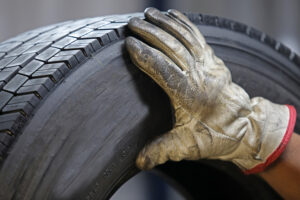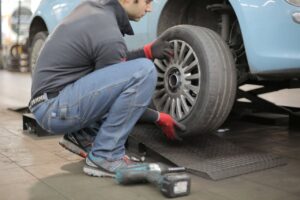What Are The Causes Of Cracks In Your Tyre?
Arguably the most important part of your car, tyres are expertly engineered pieces of equipment that help keep you safe on the roads. Without them, you wouldn’t be moving anywhere, so keeping them in good condition throughout their lifespan is paramount. Tyres don’t last forever and therefore there are some signs of wear and tear that you need to look out for, including cracking.
What causes cracks in your tyres?
High-quality tyres such as Michelin or Goodyear have a number of qualities and components that mean they can support the weight of your vehicle and keep them in the correct shape under pressure. But why exactly would your tyres crack and what causes them?
The fibres inside the tyres give it flexibility while maintaining its structure. These are called plies. Alongside these plies are beads. Beads are steel that’s coated in rubber to create a seal between the tyre and wheel rim. The rubber around the outside of the tyre that comes into contact with the road is made up of lots of polymers that are knitted together to form molecules. When these bonds break down, it causes cracks in your tyres, meaning they are unusable and must be replaced immediately to avoid any accidents. But what exactly causes these bonds to weaken and break down?
Extreme heat exposure/UV rays
There are many factors that can cause your tyres to break down and extreme heat and long exposure to UV rays can do just this. The polymers in the tyres are designed to expand in the heat and contract in the cold. However, this constant movement can risk the bonds weakening over time which is when cracks begin to appear. Exposure to UV rays can also cause this and is why tyre storage is recommended to be done in a cool, dark room.
Age
It is a well-known fact that the older tyres get, the more likely you are to experience problems and cause a higher risk of accidents occurring. As the tyres get older, the polymers start to break down, causing your tyres to harden and become brittle. This loss of elasticity can also cause cracks to appear in your tyres.
Contrary to popular belief, it is actually more beneficial to drive your car every now and then instead of leaving it parked for long periods of time. This is because when the tyre moves, the chemicals released prevent the tyre from drying out and cracking.
Water
Although yes, rubber and your tyres are waterproof, water can still permeate tyres after driving on wet roads for prolonged periods of time. If this is to occur, the water can slosh around inside the tyre which can wear it down from the inside out. As the water would expand and contract within partial cracks in your tyre, these cracks can get bigger and bigger.
Tyre Pressure
Having the correct tyre pressure is important to avoid cracks in your tyres. If your tyres are inflated incorrectly and are under pressure, more heat is conducted when they come into contact with the road which creates more friction. If your tyres are over-pressured, this can add extra stress to the tyre wall and cause bulging. This can then result in a dangerous scenario called a tyre blowout. You can read more about how tyre pressure can affect your tyres in one of our previous blogs here.
Are tyre cracks dangerous?
Driving with cracked tyres means the rigidity and strength have been compromised and risks a blowout whilst you are driving. If you notice any cracks or bulges in your tyres, it is important to get these checked by a professional at a garage before any accidents occur.
If your tyres have cracks appear or are showing signs of age, it is important to get these both checked and changed by a professional. etyres offers a mobile fitting service where our experts can come to you. Find out more information here, or head to our tyre brand’s page to choose your next replacement tyres.




